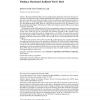101 search results - page 2 / 21 » Using Parsimony to Guide Maximum Likelihood Searches |
JACM
2006
13 years 10 months ago
2006
Abstract. Maximum likelihood (ML) is an increasingly popular optimality criterion for selecting evolutionary trees [Felsenstein 1981]. Finding optimal ML trees appears to be a very...
TCBB
2008
13 years 10 months ago
2008
Abstract-- The Maximum Parsimony problem aims at reconstructing a phylogenetic tree from DNA sequences while minimizing the number of genetic transformations. To solve this NP-comp...
BMCBI
2007
13 years 11 months ago
2007
Background: Maximum parsimony phylogenetic tree reconstruction from genetic variation data is a fundamental problem in computational genetics with many practical applications in p...
ICDAR
1999
IEEE
14 years 3 months ago
1999
IEEE
We present a method of classifying a pattern using information furnished by a ranked list of templates, rather than just the best matching template. We propose a parsimonious mode...
BIBE
2003
IEEE
14 years 4 months ago
2003
IEEE
Abstract— We analyze the performance of likelihoodbased approaches used to reconstruct phylogenetic trees. Unlike other techniques such as Neighbor-Joining (NJ) and Maximum Parsi...

